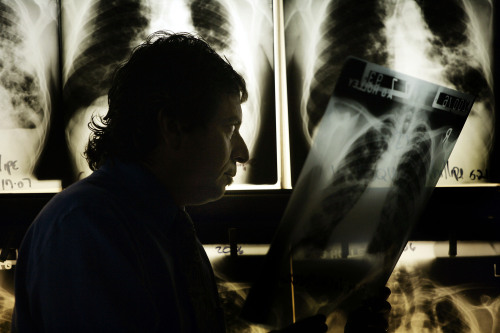Authorities announce measures to bring down TB prevalence, highest in the OECD
To many people, tuberculosis, often abbreviated as TB, is a disease in novels or TV dramas: The beautiful but pale protagonist spits blood on his or her white handkerchief and cries over their fate. A classic scene in a romantic novel.
However, the real tuberculosis is nothing romantic. The hemoptysis and excessive coughing consume all energy and contagiousness prevents even the closest family members from visiting the patient often.
As of 2009, 71,200 people have been treated for the disease in Korea and about 35,800 new patients are reported every year. That figure is equivalent to 88 of every 100,000 people suffering from the disease, with a death rate of 5.5. The prevalence and death rates are the highest among OECD member states.
Tuberculosis is a bacterial infection. The bacteria usually attacks the lungs, but can also damage other parts of the body. About 10 percent of people infected get the disease.
TB does not seem preventable except for BCG shots for infants ― the germs spread through the air when a carrier coughs, sneezes or, sometimes, talks.
 |
Dr. David Ashkin, a pulmonary specialist with a research interest in tuberculosis, examines a chest X-ray at A.G. Holley State Hospital in Florida. (Bloomberg) |
Therefore, the U.S. National Institutes of Health advises people who have had a cough that lasts three weeks or longer, or have experienced weight loss to visit the nearest clinic to get examined. Weakness or fatigue, coughing up blood or mucus, fever, chills and night sweats are also symptoms.
Staying in clean air and taking plenty of rest, medication is enough for most patients to recover.
Still, drug-resistant TB affects 3,000 new people every year. This ultra-powerful form of the disease is known to be resistant against conventional TB drugs such as isoniazid and rifampicin, and requires extra care.
“About half of MDR-TB patients die within seven years if not treated at an appropriate time. Because the primary stage of the disease is similar to catching a cold, many people do not take it seriously,” Dr. Lee Sang-hak of Catholic University said.
The Ministry of Health and Welfare and the Centers for Disease Control and Prevention on Wednesday announced a set of guidelines to bring down the prevalence of TB to the OECD average of 17.7 per 100,000.
Those who register themselves as TB patients or TB germ careers will be subsidized for half the cost of medication. Currently, the National Health Insurance covers 90 percent of the treatment cost and the patient has to pay only 10 percent, but the new rules will reduce the amount borne by patients to 5 percent, the KCDC said.
Hospitalization for quarantine will be supported too, while the state will look after low income patients’ families when the main income earner undergoes treatment.
Authorities also mandated that family members and people who share spaces with TB carriers or patients take regular checkups to contain the further spread of the disease.
“TB is rather a controllable disease if one keeps medication and other rules in life. We hope the guidelines could eradicate the disease in the future,” KCDC Chief Lee Jong-ku, said.
By Bae Ji-sook (
baejisook@heraldcorp.com)





![[Exclusive] Hyundai Mobis eyes closer ties with BYD](http://res.heraldm.com/phpwas/restmb_idxmake.php?idx=644&simg=/content/image/2024/11/25/20241125050044_0.jpg)
![[Herald Review] 'Gangnam B-Side' combines social realism with masterful suspense, performance](http://res.heraldm.com/phpwas/restmb_idxmake.php?idx=644&simg=/content/image/2024/11/25/20241125050072_0.jpg)

